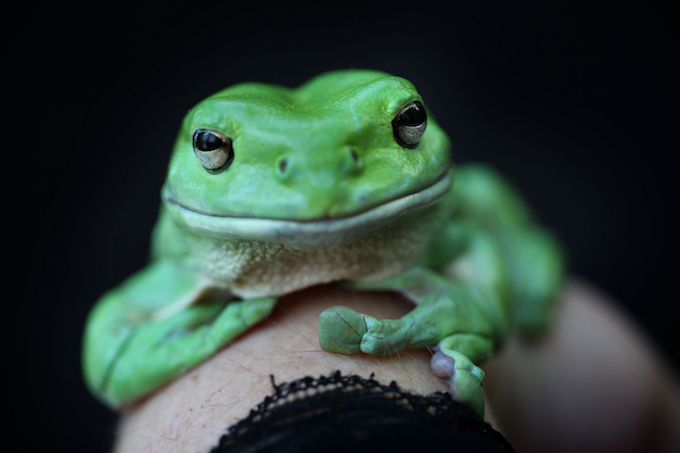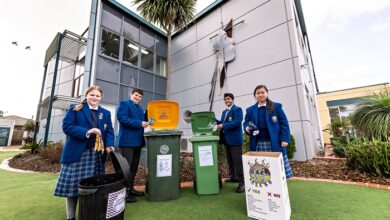Schools can help save the frogs by taking part in Australia’s biggest frog count

Australia’s frogs are calling for help and schools can play a key role in saving them by taking part in Australia’s biggest frog count.
FrogID Week takes place November 9-18 as the next phase of the Australian Museum (AM)’s FrogID citizen science program, which is aimed at collecting frog calls across the nation – at a moment in time – to establish a benchmark from which frog populations can be monitored annually.
Schools can help save Australia’s frogs by recording the sounds of frogs during FrogID Week. Simply download the free FrogID app on your phone and, during FrogID Week 9-18 November 2018, head outside to listen for frogs. When you hear a frog, record the sound with the FrogID app and submit it to the FrogID program. It’s easy and it’s free.
Dr Jodi Rowley, Australian Museum Curator of Amphibian & Reptile Conservation Biology, said public help during FrogID Week was vital to collect all the information scientists need to track the health of Australian frog populations.
“There are frogs all over Australia – in remote areas, deserts, bushland, rainforests, on grazing land, in lakes and dams, on private properties, in suburban back gardens and in our busy cities – so we need everyone around the nation to listen for and record frog calls during FrogID Week. We need to collect as much information as possible to help the 240 species of frogs that live in this country.” said Dr Rowley.
The AM and the FrogID team are calling on all Australians to participate in FrogID Week. We have priority species we need your help to find, including missing, threatened and other priority frogs.
Priority missing or threatened frog species:
· Peppered Tree Frog (Litoria piperata) – Vulnerable – not seen since the 1970s
NSW New England tablelands
· Booroolong Frog (Litoria booroolongensis) – Endangered
NSW New England tablelands, NSW southern highlands, extreme eastern Victoria
· Yellow-spotted Bell Frog (Litoria castanea) – Endangered
NSW New England tablelands, NSW southern tablelands, ACT
· Southern Bell Frog (Litoria raniformis) Vulnerable
Victoria, southern NSW, north eastern Tasmania, extreme eastern South Australia
· Green and Golden Bell Frog (Litoria aurea) Vulnerable
NSW, Victoria
· Green-thighed Frog (Litoria brevipalmata) – Vulnerable in NSW
Coastal south eastern Queensland, north eastern NSW
· Southern Barred Frog (Mixophyes balbus) – Vulnerable
Eastern NSW to extreme north eastern Victoria
· Giant Burrowing Frog (Heleioporus australiacus) – Vulnerable
South eastern NSW, north eastern Victoria
Other priority frog species
· Red Tree Frog (Litoria rubella)
Widely distributed in Western Australia, Northern Territory, South Australia, Queensland and NSW
· Desert Froglet (Crinia deserticola)
Queensland, Northern Territory, extreme north eastern Western Australia, extreme north NSW
· Copland’s Frog (Litoria coplandi)
Northern part of Northern Territory and Western Australia, extreme north eastern Queensland
· Spencer’s Burrowing Frog (Platyplectrum spenceri)
Central Northern Territory, Western Australia, northern South Australia and south western Queensland
· Red-crowned Toadlet (Pseudophryne australis) – Vulnerable in NSW
Sydney NSW
In the past year, FrogID participants have helped record more than 30,000 frog calls and identified 166 frog species, including frogs which the AM did not previously have audio recordings of:
- More than 60,000 downloads of the app
- More than 14,750 registered users
- More than 36,000 recordings submitted
- More than 45,000 verified frogs
- 174 frog species identified
Dr Rowley said the information gathered in the past 12 months has created an audio ‘map’ of Australian frogs, but there was still so much more to be done.
“FrogID Week is the next really important part of our program – the high number of recordings we hope to gather at the same time each year during FrogID Week will allow us to compare year-on-year how our frogs are coping so we can make informed conservation decisions,” said Dr Rowley.
“Frogs are good indicators of the health of the environment, as they are highly sensitive to changes on land and in the water, so understanding how healthy our frogs are also helps us track threats to biodiversity and the broader impact of change on the land, other native animals and even for our own communities.”
WHY FROGS COUNT
Australia has 240 known species of native frogs, many of which are under threat. Hundreds of frog species have already disappeared worldwide and many more are on the edge of extinction.
Sir David Attenborough has described amphibians as “the lifeblood of many environments”. As one of the first animal species to feel the impact of environmental changes, declining frog populations are a “warning call” about the impacts of climate change and pollution on Australia’s waterways, wildlife and ecosystems.
Frogs also play a critical role in the management of insect pests. Frog-skin secretions are also being explored in drugs to fight infection, release insulin, regulate the heart and cure diseases, such as cancer.







